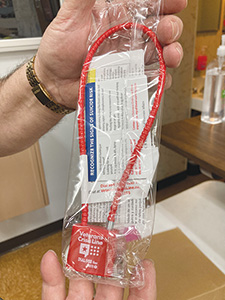By ELIZABETH DONALD
Illinois Correspondent

East Alton, IL – The construction industry is in a silent crisis.
Last year, nearly 50,000 Americans died by suicide, at a rate of 5.7 suicide deaths per hour and roughly twice the rate of homicide. That’s the highest number ever recorded in the U.S.
In the past two decades, the national suicide rate, or the number of suicides per 100,000 people, shot up about 35 percent.
Construction workers are at particularly high risk. The suicide rate for construction workers is the second highest of any industry, according to the federal Centers for Disease Control and Prevention (CDC).
According to the CDC, major industry groups with the highest suicide rates include construction and extraction; farming, fishing and forestry; personal care and service; installation, maintenance and repair; arts, design, entertainment, sports and media.
DOING SOMETHING ABOUT IT
Nick Dodson, sergeant-at-arms for the Madison County Federation of Labor and AFL-CIO Labor Liaison to the United Way, recently applied for a grant from the Illinois Department of Public Health and received 200 gun locks to help with this growing issue. Most are already spoken for. He is hoping to get more in time for a suicide prevention event currently in the planning stages for June.
“It’s been running this way for a lot of years, and we are doing what we can,” said Dodson, a member of Plumbers/Gasfitters Local 360. “If it prevents a single suicide, it’s worth it.”
Dodson notes that 55 percent of suicides are completed with a firearm. The gunlock isn’t so complicated as to prevent the gun’s use altogether if needed for personal defense, but it slows down the user just a bit, creating a pause between decision-making and action.

“(The lock) gives a moment of pause, to slow down the decision-making,” he said. Sometimes that moment of pause is all it takes to reconsider a terrible decision.
The American Foundation for Suicide Prevention (AFSP) says the most important thing you can put between a suicidal person and their way of ending their life is time.
“Research shows that by temporarily reducing a suicidal person’s access to lethal means, we give suicidal individuals time – time for the intense suicidal risk to diminish and time for someone to intervene with mental health support and resources,” AFSP says.
“For the majority of people who experience a suicidal crisis, if unable to access their chosen method even temporarily, they are unlikely to engage in another action to end their lives.”
ALLIANCE FOR SUICIDE PREVENTION
In 2016, the Construction Financial Management Association created the Construction Industry Alliance for Suicide Prevention (CIASP), with the goal of shattering the stigma surrounding mental health issues. The organization went independent in 2018 and has continued to study this issue and worked to prevent suicides in the construction industry.
The alliance’s website states that across the board, male-dominated industries have more suicides. A major part of the issue is substance abuse: Construction work is hard on the body, and use of opioid painkillers can lead to addiction and risks with fentanyl in illicit painkillers.
“The macho, tough-guy, and stoic nature of construction workers can even discourage those who are most at risk for suicide from seeking help,” they wrote. “Men, especially white men in their early 20s through their 50s, account for the bulk of suicides.”
Despite recent attempts to diversify the construction field, the Bureau of Labor Statistics confirms that the construction workforce is still 97 percent male. Many veterans also choose construction as a career, and veterans are also at a higher risk than the general population.
IF YOU’RE IN CRISIS
If you or someone you know is in crisis, call or text 988 to reach the 988 Suicide and Crisis Lifeline or visit 988lifeline.org.
Suicide prevention on the jobsite
The Construction Industry Alliance for Suicide Prevention recommends several actions the construction industry, unions and others can take to fight suicide:
• Employers need to ask if mental health is discussed in the workplace with the same rigor as physical health and safety. Find out which groups are experiencing the most stress, and what they think of the mental health services offered to employees. What are the barriers to accessing mental health services?
• Train supervisors how to have difficult conversations. Consider it like CPR for mental health: practicing active listening, asking difficult questions, and referring people to qualified resources without judgement.
• Increase awareness. Give toolbox talks on psychological safety, possibly bringing in your employee assistance program providers for lunch-and-learn sessions on mental health and coping techniques.
• Integrate mental health into the overall health program. Offer workshops in topics like conflict resolution, healthy sleep, stress management, money matters, pain management, responsible drinking and more. Find out more about screening for mental health at https://screening.hfihub.com/mwi.
• Review policies for medical leave due to mental health. According to CIASP, there should be no discrimination against mental health crises vs. other kinds of health crisis such as a heart attack.
• Participate in awareness campaigns. National Alcohol Screening Day is in April, Mental Health Awareness Month and National Anxiety Screening Day are in May, Suicide Prevention Awareness Month is in September, with World Suicide Prevention Day on Sept. 10., and National Depression Screening Day is in October, along with International Survivors of Suicide Loss Day in November.
• Include informational articles in the company newsletter, including FAQs about therapy and resources for mental health, depression, trauma and alcohol dependence.
If you or someone you know is in crisis, call or text 988 to reach the 988 Suicide and Crisis Lifeline or visit 988lifeline.org.
Employers and unions should also promote this resource; the website includes posters and wallet cards in English and Spanish for workplaces and union halls.


